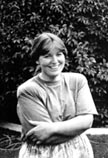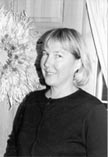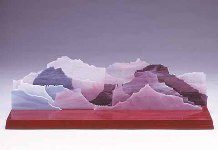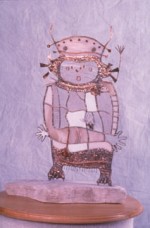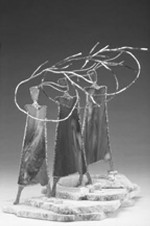"'Domes and Pinnacles' began because I was fascinated with the names of canyons and landmarks in the San Rafael Swell. I read the book Canyoneering and had gone to many of the areas described in that guidebook. One day, while hiking in the Red Canyon area, I decided to play around with the names. I remember taking at least a few months tinkering, grouping places for sound and meaning.
Karen made a glass sculpture of canyons in colors mentioned in the poem. However, each piece of glass is on runners, moveable so one can create the scene she or he wants."
Domes and Pinnacles
Window-blind Peak.
Old Woman Wash.
Quandary Canyon.
I run my finger
under the names
of anticlines, upheavals.
Mineral Flats.
Cathedral Mountain.
Goblin Valley.
They're all out there.
I could pack
my jeep anytime of year
any evening before
a lava sunset or one in
rose.
I could take a spin
toward the horizon where
jaggeds would appear, a city of rock
that I'd follow
inside to the canyons,
where I'd get out,
slip through
like a spider, to find
holds on cliffs
obsidian with waterfalls,
and climb.
I could go out there
where there's cold,
spectacular
music, and under it the
hanging gardens.
I've been there before.
I can feel
the slanted floors and
walls as I
dissolve them into my own
Honesty's Ledge.
A boulder like my living room
falls from miles
up valley, and I'm there
when it does.
I put away the guide.
I cold-wash the red laundry.
I'm in a house
of crimson, burnt petals,
icy cranberry,
white strata.
I ignore the swinging bridge,
hike to the pinnacled fins
over the crush
of solid squares askew.
I wall over dinosaur backs of rock,
breathe all the spicy dust I want
remembering this life
back here, entering bedrock,
deeper into the Wedge.
Into Foil Arch, the Frying Pan,
into Drowned Hole Draw, Box Spring,
into Furniture Draw, Lockhart Box,
into Red Seep, Jump Trail,
up to the Woman Pinnacle,
into the Maze,
and begin my long descent to the river.
"We didn't begin with a set idea and what emerged for each of us was very new work that weaves the natural world, women's relationships, and life in the West." language: Wild Woman Draw,
"The persona in `Preserves' came from my yearly batch of crabapple jelly. There is a beauty and a frustration in the preserving of fruit. The filled jars are gorgeous. Canning is messy, takes a long time, and must be exact. It is both time-consuming and pleasing, like making a work of art.
The poem suggests a psychic division in the persona, one I know many writers feel, so what is being 'preserved' in the poem is metaphorical to me now.
The sculpture is made with peach-colored, multi-textured glass and stones 'preserved' inside a small cage, which is welded into the center of the figure."
Preserves
Quiet and glassy. So neatly spooned. Almost whole
and buoyant, suspended.
Airtight.
She's got them now.
Still.
Pitted.
She examines the shelves. She isn't without words:
Early Girls! Better Boys!
Blue Jams! Ears of Peaches!
Slim Squashes! Gruel of Relishes!
She knows this cellar, this refuge.
One at a time she'll
bring them up.
"Before each pair of work was completed, we met several times to see how the two works would complement each other, and we'd make decisions based on the shared nature of the pieces. Each new examination of our work provided a mystery that had to be solved, and deepened."
Thought Woman
In Keres theology…in the beginning existed Thought Woman and her dormant sisters. Thought Woman thinks creation and sings her two sisters into life. —From Grandmother of the Sun by Paula Gunn Allen
When I'm alone, I'm undecided
as to whether I'm whole,
the cool light I gather
too much for me, the basket I
weave not tight enough
to carry water.
There is no one to say my life
is a life, but I know
what the wild onion feels.
I'm not yet a survivor, or
a victim over and over.
Tonight I'll leave again,
believing in this clay charm.
I'll find the center
and turn myself into
the part of me that flies.
Only what I've made
I have to leave behind:
a red-rock dish,
willows I spoke with.
I love not having a home,
my loneliness, though sometimes
I think of sisters, those
of no means like myself,
creations like the grasses
beginning to grow here,
this world beginning
to fan out and sail by
like the deer I just
pulled into a finished
drawing. These sisters
wouldn't be shadows
but a loose blue cloth.
Then, if we thought more,
there would be more of us,
divining, making.
In another world
I was always afraid of something,
terrible words as someone
held my wrists near a river. Was all
that my least favorite color?
I know alone I can part stone
in my path, order spring
and more red for my dye. I
take in this winter's
billowed sky, the frozen falls,
shining stubble. I can always
search out shelter, distill
rooms of snowy gardens. In me,
I have these possibilities.
There in Dark Canyon
it will be easy to swim
the green pools
and let go of my voice.
Then it will come back to me.
We'll be keepers of spring floods,
wild mint.
Unlike me, a wanderer—
one might be a stayer,
another an asker.
"Many times a few early lines of a poem would suggest an image to Karen, and she would sketch out a sculpture. We would discuss her sculpture, looking at its shape, colors, texture together on paper while sitting at her kitchen table in Spring Glen drinking coffee. This subconscious, social collaboration helped me to realize what words I wanted to work into the poem, what shape it should take. Karen herself might have spoken a part of the poem."

